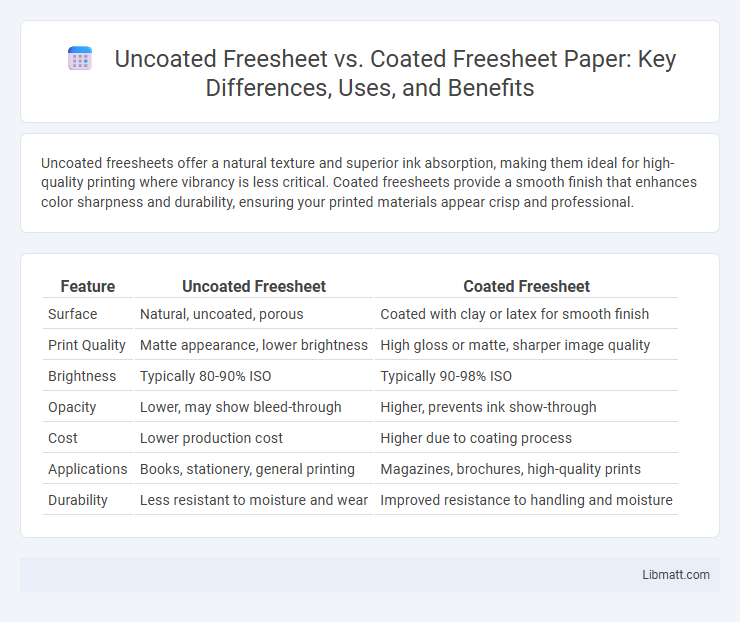Uncoated freesheets offer a natural texture and superior ink absorption, making them ideal for high-quality printing where vibrancy is less critical. Coated freesheets provide a smooth finish that enhances color sharpness and durability, ensuring your printed materials appear crisp and professional.
Table of Comparison
| Feature | Uncoated Freesheet | Coated Freesheet |
|---|---|---|
| Surface | Natural, uncoated, porous | Coated with clay or latex for smooth finish |
| Print Quality | Matte appearance, lower brightness | High gloss or matte, sharper image quality |
| Brightness | Typically 80-90% ISO | Typically 90-98% ISO |
| Opacity | Lower, may show bleed-through | Higher, prevents ink show-through |
| Cost | Lower production cost | Higher due to coating process |
| Applications | Books, stationery, general printing | Magazines, brochures, high-quality prints |
| Durability | Less resistant to moisture and wear | Improved resistance to handling and moisture |
Introduction to Freesheet Paper Types
Freesheet paper types include uncoated and coated varieties, each serving distinct printing and writing needs. Uncoated freesheet offers a natural, porous surface ideal for smooth ink absorption and a matte finish, commonly used in books, stationery, and high-quality printing. Coated freesheet features a surface treated with pigments or clay, enhancing brightness, smoothness, and print sharpness, making it preferred for magazines, brochures, and high-resolution images.
What is Uncoated Freesheet Paper?
Uncoated freesheet paper is a high-quality paper made from wood pulp without a surface coating, offering a natural texture and excellent printability for text and graphics. It is commonly used for letterheads, stationery, and books where a more tactile, matte finish is preferred over the glossy, smooth finish of coated freesheet paper. Your choice between uncoated and coated freesheet depends on the desired aesthetic, durability, and printing requirements of your project.
What is Coated Freesheet Paper?
Coated freesheet paper features a surface layer of pigments such as clay or calcium carbonate, providing a smooth finish that enhances print quality and color vibrancy. It is commonly used in high-end publications like magazines, brochures, and catalogs due to its superior brightness and sharper image reproduction. Unlike uncoated freesheet, coated freesheet offers improved ink holdout and reduced paper absorbency, resulting in crisper text and more vivid graphics.
Key Differences: Uncoated vs Coated Freesheet
Uncoated freesheet paper has a porous surface that absorbs ink quickly, making it ideal for writing and printing with a natural texture, whereas coated freesheet features a smooth, sealed finish that enhances color vibrancy and sharpness in printed images. Coated freesheet's glossy or matte coating reduces ink absorption, resulting in higher print quality and faster drying times compared to the more absorbent uncoated variety. Your choice between these papers depends on whether priority lies in tactile feel and versatility with writing instruments or in delivering crisp, visually striking prints.
Printing Performance: Uncoated vs Coated Freesheet
Uncoated freesheet paper offers superior ink absorption, resulting in softer, more natural images but lower print sharpness compared to coated freesheet, which features a sealed surface that enhances color vibrancy and detail precision. Coated freesheet sheets provide better resistance to smudging and faster drying times, making them ideal for high-quality graphic printing and professional publishing. The choice between uncoated and coated freesheet ultimately depends on the desired finish, image clarity, and printing method used.
Visual Appeal and Surface Texture Comparison
Uncoated freesheet paper features a natural, matte finish that provides a soft, tactile surface with excellent ink absorption, enhancing readability and a sensory connection to the printed material. Coated freesheet paper has a smooth, glossy or satin surface created by a coating layer that improves brightness, sharpness, and color vibrancy for high-quality image reproduction. The visual appeal of coated freesheet is typically more vibrant and polished, while uncoated freesheet offers a more understated and organic aesthetic with a textured feel.
Typical Applications for Uncoated Freesheet
Uncoated freesheet is commonly used for applications requiring high-quality printing with a natural, matte finish, such as letterheads, stationery, books, and brochures. This paper type excels in ink absorption, making it ideal for detailed text and images without glare, ensuring readability and a professional appearance. Your projects benefit from the paper's smoothness and strength, which support precise printing and handling in office and publishing environments.
Typical Applications for Coated Freesheet
Coated freesheet is primarily used for high-quality printing applications such as magazines, brochures, and catalogs where sharp image reproduction and vibrant colors are essential. Its smooth surface enhances ink holdout, making it ideal for detailed graphics and photographic content. You can rely on coated freesheet for premium marketing materials that demand a polished and professional appearance.
Environmental Impact: Uncoated vs Coated Freesheet
Uncoated freesheet paper typically has a lower environmental impact than coated freesheet due to its simpler production process that requires fewer chemicals and less energy consumption. The absence of surface coatings, often made from synthetic polymers, facilitates easier recycling and reduces landfill waste. Coated freesheet, while offering superior print quality, generally involves higher carbon emissions and challenges in biodegradability, making uncoated options more sustainable for eco-conscious printing needs.
Choosing the Right Freesheet Paper for Your Project
Uncoated freesheet paper offers a natural texture and improved ink absorption, making it ideal for projects requiring a matte finish and high readability. Coated freesheet paper features a smooth, glossy surface that enhances color vibrancy and sharpness, perfect for high-quality photo prints and marketing materials. Your choice depends on the desired visual impact and printing technique to ensure optimal results for your project.
UNCOATED freesheet vs coated freesheet Infographic

 libmatt.com
libmatt.com